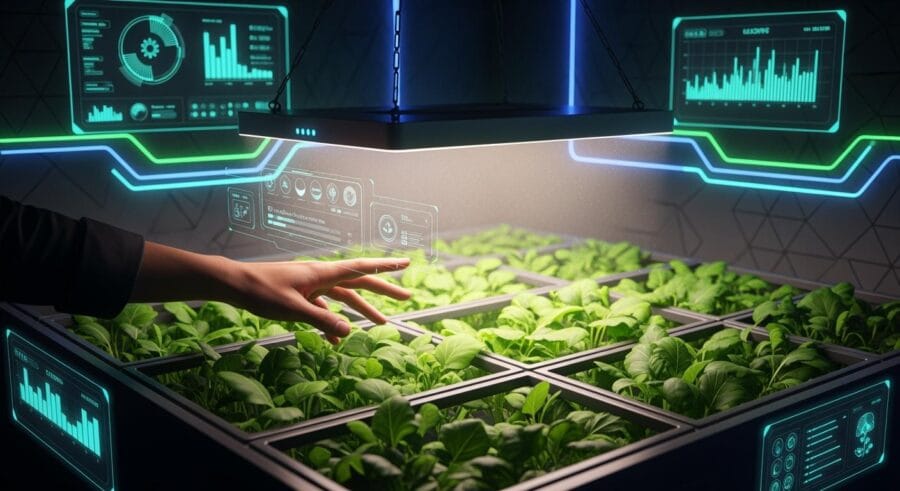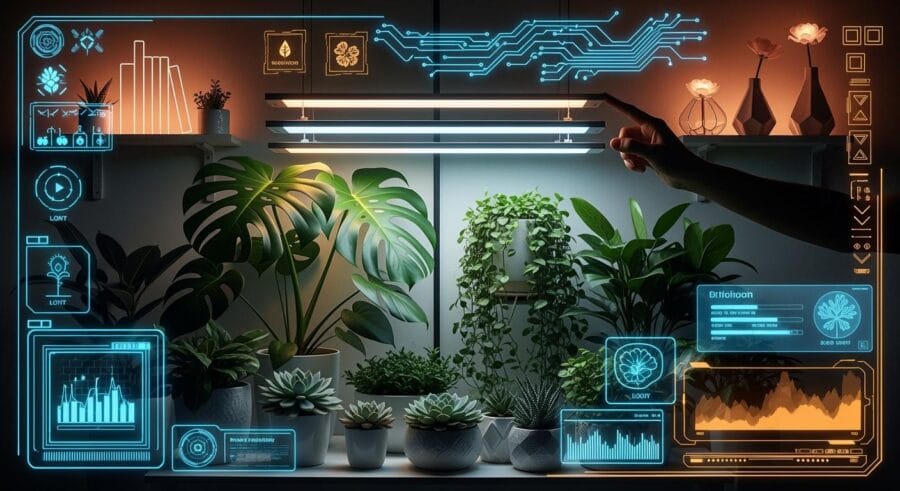-
2500 S Ann Arbor Ave, Oklahoma, OK 73128, USA
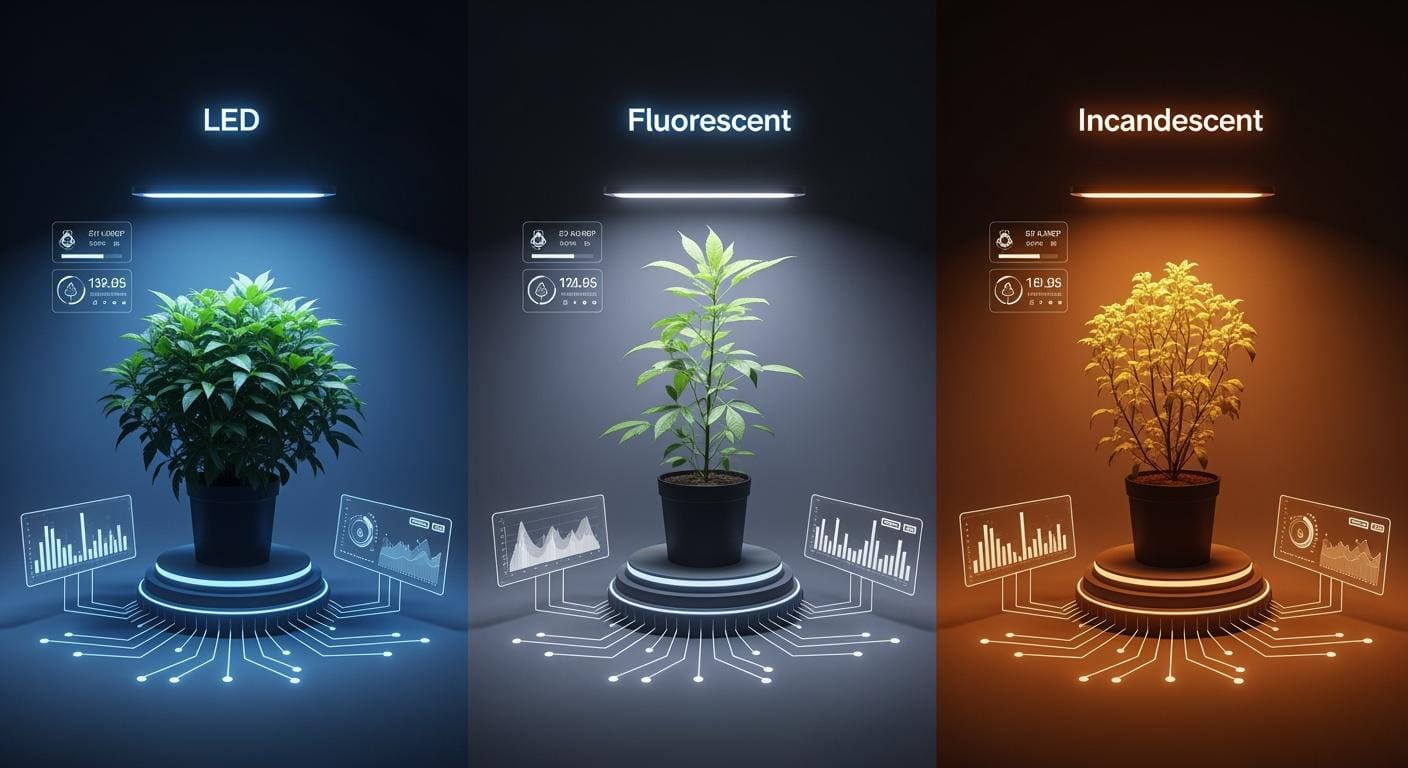
Plant Grow Lights Showdown LED, Fluorescent, or Incandescent
You want your plants to do well, but your home may not have enough sunlight. Many beginners and hobbyists pick plant grow lights because they help plants stay healthy all year. This is helpful in rooms with little natural light. Picking the right grow light matters for how well it works, how much it costs, how long it lasts, and how much energy it uses. Most people think led options, like SLTMAKS LED grow lights, are best for most plants. These lights use less energy and last longer than other types. They give your plants the light they need to grow strong and healthy.
Table of Contents
Key Takeaways
- LED grow lights are the most efficient option. They use less energy and last longer than other types.
- Fluorescent lights are great for starting seeds and growing leafy greens. They are cheaper upfront but need more frequent replacements.
- Incandescent bulbs are not ideal for plant growth. They produce too much heat and have a limited light spectrum.
- Choose LED lights for a wide range of plants. They provide the best light quality and energy savings over time.
- Consider your budget and plant needs when selecting a grow light. LEDs may cost more initially but save money in the long run.
- Keep LED lights 6-12 inches above plants for optimal growth. Fluorescent lights should be 4-6 inches away.
- Regular household bulbs do not provide the right light spectrum for plants. Use specialized grow lights instead.
- SLTMAKS LED Grow Lights offer a full spectrum of light and come with a 3-year warranty, ensuring reliable performance.
Plant Grow Lights Comparison
Quick Table Overview
You can quickly compare the main types of plant grow lights using the table below. This table shows how led, fluorescent, and incandescent options stack up in key areas.
| Feature | LED Grow Light | Fluorescent (CFL) | Incandescent |
|---|---|---|---|
| Energy Efficiency | High | Moderate | Low |
| Heat Output | Low | Moderate | High |
| Spectrum Control | Full spectrum available | Moderate | Limited |
| Lifespan | 50,000-100,000 hours | Moderate | Short |
| Light Intensity | 400-1300 µmol/m²/s | Often low | Very low |
| Initial Cost | Higher | Lower | Lowest |
| Long-Term Cost | Lower | Moderate | Highest |
| Ease of Use | Simple, one bulb | Needs two tubes | Simple, but not ideal |
💡 Tip: You can see that led grow lights offer the best mix of efficiency, lifespan, and light quality for most plants.
Key Differences
When you choose a grow light, you want to know what sets each type apart. Here are the main differences you should consider:
- LED grow lights give you high energy efficiency. You use less power and save money over time. These lights produce less heat, so you can place them closer to your plants without burning them. You also get a full spectrum of light, which helps your plants grow strong. Most led lights last for years, so you do not need to replace them often.
- Fluorescent lights, often called cfl, work well for starting seeds or growing leafy greens. They use more energy than led lights but less than incandescent bulbs. You need to use both warm and cool tubes to give your plants the right spectrum. Fluorescent bulbs do not last as long as led, so you will need to replace them more often.
- Incandescent bulbs cost the least at first, but they use a lot of energy and make a lot of heat. These bulbs have a limited spectrum, so your plants may not get the light they need to thrive. You will need to change these bulbs often because they burn out quickly. Most growers do not use incandescent bulbs for plant grow lights because they do not support healthy growth.
You can see that led and cfl options work best for most indoor gardens. Led lights, like those from SLTMAKS, give you the best results for a wide range of plants. Fluorescent lights can help if you want a lower upfront cost or need to start seedlings. Incandescent bulbs do not meet the needs of most plants and cost more in the long run.
Light Output for Plants
Picking the right grow light helps your plants grow better indoors. Each type—led, fluorescent, and incandescent—has its own good and bad points. You should know how each one changes how your plants grow. This is important if you want healthy plants all year.
LED Grow Light Benefits
Full Spectrum for Plants
Led grow lights are special because they give plants a full spectrum of light. This is a lot like sunlight. The full spectrum helps plants do photosynthesis. That means your plants can grow faster and stronger. Red light in led bulbs helps plants grow more leaves and gives bigger harvests. Blue light keeps plants short and helps them make more vitamin C. Full spectrum bulbs work best if you want to grow vegetables, herbs, or fruit inside.
🌱 Tip: Led lights use less energy and make less heat. You can put them close to your plants without burning the leaves.
Here is a quick look at how led lights help your plants:
| Light Color | Plant Benefit |
|---|---|
| Red | Helps plants grow more leaves and bigger crops |
| Blue | Makes plants short and gives them more color |
SLTMAKS Features
SLTMAKS LED Grow Lights have many features that help plants do well. These lights use Samsung diodes to make a light like the sun. You get strong led light but use less energy. The cooling system uses a solid aluminum heat sink. This keeps the lights quiet and helps them last longer. SLTMAKS lights have ETL and CE certifications. This means they are safe to use. The special technology helps your indoor garden do its best.
| Feature | Description |
|---|---|
| Pro-Grade Full Spectrum | Uses Samsung diodes for sun-like light, boosting yield and quality with low energy use |
| Advanced Cooling & Durability | Solid aluminum heat sink for silent, fanless operation and longer lifespan |
| Certified Safe & Patented Tech | ETL & CE certified, with unique technology for safety and top performance |
You can use SLTMAKS lights for many plants. They work for starting seeds, growing hemp, vegetables, and fruit. The full spectrum and strong led light make these lights a great pick for plant grow lights.
Fluorescent Light for Plants
Spectrum and Intensity
Fluorescent grow lights give plants a wide spectrum of light. But it is not as complete as led lights. These lights are good for general plant growth and are easy to find. Fluorescent bulbs are bright enough for many indoor plants, especially when they are young. For strong growth during flowering, you need about 7000 to 7500 lumens for each square foot. This much light helps plants grow thick stems and leaves.
Best Uses
Fluorescent lights are best for seedlings and leafy greens. These lights do not get very hot. You can put them close to young plants. Fluorescent bulbs work best for:
- Seedlings that need soft, steady light
- Greens and herbs that do not need strong light
- General plant growth in small indoor gardens
If you want an easy and cheap way to start seeds or grow lettuce, fluorescent lights are a good choice.
Incandescent Light for Plants
Heat and Spectrum
Incandescent grow lights make a lot of heat and have a small light spectrum. Most of the energy from these bulbs turns into heat, not useful light. If you put incandescent bulbs too close, you might burn the leaves or stop the plants from growing. You need to keep these bulbs far enough away to keep your plants safe.
- Incandescent bulbs make a lot of heat, which can hurt plants if you are not careful.
- Signs of heat damage are burnt leaves and slow growth.
- You must keep the light far enough from the plants to stop too much heat.
Limitations
Incandescent lights do not help most indoor plants grow well. The small spectrum does not give enough red or blue light for photosynthesis. You also have to change these bulbs a lot, which costs more money and time. Most people use led or fluorescent lights for better results and safer use.
⚠️ Note: Incandescent bulbs may look cheap at first, but they do not give your plants the light they need to do well.
When you know how each grow light works, you can pick the best one for your plants. Led grow lights, like SLTMAKS, give the best mix of spectrum, brightness, and safety. Fluorescent bulbs are good for starting seeds and growing leafy greens. Incandescent bulbs have more problems and do not help indoor gardens as much.
Energy Efficiency & Cost
Choosing the right grow light can save you money and help your plants thrive. You want to know how much energy each type uses and what you will pay over time. This section breaks down the differences between LED, CFL, and incandescent options, so you can make the best choice for your indoor garden.
LED vs CFL and Incandescent
Power Use
You can see big differences in how much electricity each grow light uses. LED bulbs use the least energy, while incandescent bulbs use the most. CFL lights fall in the middle. The table below shows how much power each type needs to produce the same amount of light.
| Light Output | LED | CFL | Incandescent |
|---|---|---|---|
| 450 lumens | 6W | 9W | 40W |
| 800 lumens | 10W | 14W | 60W |
| 1100 lumens | 14W | 18W | 75W |
| 1600 lumens | 18W | 23W | 100W |
🌱 Tip: You can save up to 80% on your energy bill by switching from incandescent to LED grow lights.
SLTMAKS LED Grow Lights stand out because they use advanced technology to deliver high light output with less power. You get energy savings of 20-30% compared to standard fluorescent and incandescent lights. This means you use less electricity and help the environment at the same time.
Cost Over Time
The cost to run your grow light adds up over the year. LED lights cost the least to operate, while incandescent bulbs cost the most. CFL bulbs are in between. The chart below shows the annual energy use for each type at common wattages.
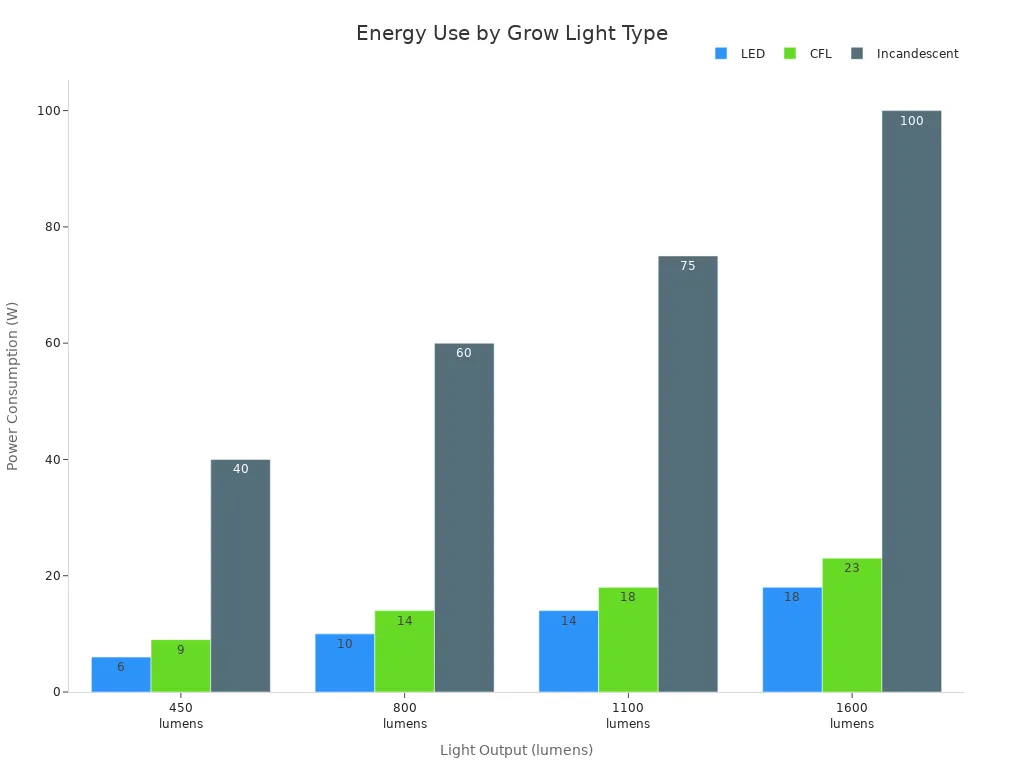
If you use a 10W LED for 8 hours a day, you spend about $7.30 per year. A 60W incandescent used the same way costs about $73.01 per year. That is a big difference for your wallet.
Upfront vs Long-Term Costs
Replacement Frequency
You also need to think about how often you must replace your grow light. LED grow lights last much longer than fluorescent bulbs or incandescent bulbs. The table below shows how often you need to replace each type.
| Type of Grow Light | Replacement Frequency |
|---|---|
| LED | 5 to 10 years |
| Fluorescent (T5) | 10,000 to 20,000 hours (about 1.5 to 2 years) |
| Incandescent | 6 to 9 months |
You will change incandescent bulbs many times before you need to replace an LED. Fluorescent bulbs last longer than incandescent, but not as long as LED.
Value for Money
When you look at the total estimated cost, LED grow lights give you the best value. You pay more at first, but you save money on energy and replacements. SLTMAKS LED Grow Lights come with a 3-year warranty, so you know you are making a smart investment. You also get energy efficient lighting that helps your plants grow strong.
The payback period for switching from incandescent or fluorescent bulbs to LED is often less than one year. Sometimes, with rebates, you can see savings even faster. Over time, you spend less and get better results for your plants.
💡 Note: When you compare LED vs CFL and CFL vs incandescent, LED always comes out ahead for efficiency, cost comparison, and long-term savings.
If you want to keep your indoor garden healthy and your bills low, choose LED grow lights like SLTMAKS. You will see the difference in your plants and your wallet.
Lifespan & Maintenance
When you choose plant grow lights, you want to know how long they last and how much work they need. Each type—LED, fluorescent, and incandescent—offers different lifespans and maintenance needs. Understanding these differences helps you save time and money while keeping your plants healthy.
LED Durability
LED lights stand out for their long lifespan and low maintenance. Most LED grow lights last between 50,000 and 100,000 hours. That means you can use them for many years before you need a replacement. Take a look at this table to see how LED compares to other types:
| Type of Light | Average Lifespan (hours) |
|---|---|
| Incandescent | 1,000 |
| Halogen | 2,000 |
| Compact Fluorescent | 15,000 |
| LED | 50,000 |
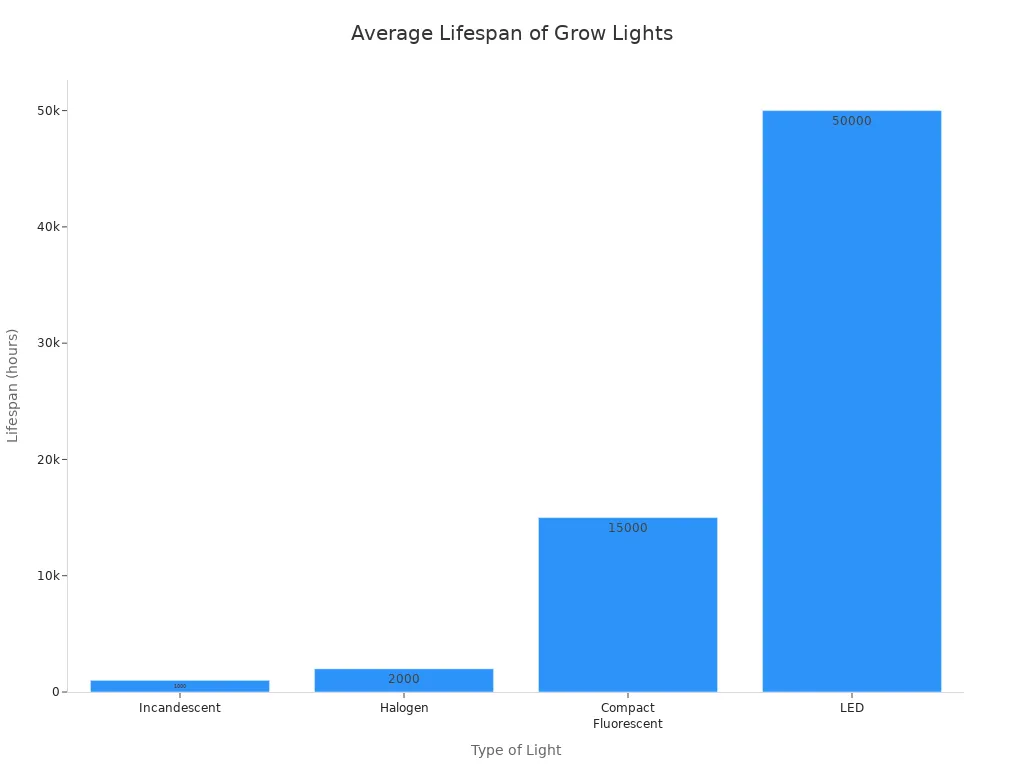
SLTMAKS Warranty
SLTMAKS LED grow lights come with a 2-year warranty. This gives you peace of mind if you want reliable lighting for your plants. While some brands offer longer warranties, the SLTMAKS warranty still covers you for a long period. You can trust your investment will last.
Maintenance Tips
You can keep your LED grow light working well with simple steps:
- Clean the light surface often to remove dust.
- Check that you install the light properly for even coverage.
- Make sure the area has good airflow to prevent overheating.
LEDs do not need ballasts or frequent bulb changes. This makes them the most energy efficient and easy to care for.
Fluorescent Longevity
Fluorescent lights last about 15,000 hours on average. This is much longer than incandescent bulbs but shorter than LEDs. You will need to replace tubes and sometimes ballasts during their life.
Replacement Needs
You should check your fluorescent tubes every few months. If you see flickering or dim light, it is time to replace the tube. Ballasts can also fail and need replacement.
Upkeep
To keep your fluorescent lights working well:
- Wipe down fixtures to stop dust from blocking light.
- Replace tubes and ballasts as needed.
- Dispose of old tubes safely because they may contain hazardous materials.
Fluorescent lights need more upkeep than LEDs, which can add to your costs over time.
Incandescent Lifespan
Incandescent bulbs have the shortest lifespan. Most last about 1,000 hours, so you will need to change them often.
Frequent Changes
You can expect to replace an incandescent bulb about once a year if you use it for plant lighting. This means more trips to the store and more waste.
Maintenance Issues
Incandescent lights need frequent attention. You must check for burnt-out bulbs and replace them quickly. These bulbs also use more energy and create more heat, which can make maintenance harder. Over five years, you will spend more on replacements and energy than with other types.
🛠️ Tip: If you want less work and more efficiency, choose an energy efficient LED grow light for your plants.
Practical Considerations
Heat Output & Safety
LED Cooling
You want your indoor garden to be safe. LED lights make very little heat. You can put them close to your plants. You do not have to worry about burning leaves. Many LED models like SLTMAKS use quiet heat sinks. They do not need loud fans. This keeps your garden cool and quiet. It also lowers the chance of overheating. Your plants and your home stay protected.
Fluorescent Heat
Fluorescent lights make more heat than LEDs. But they make less heat than incandescent bulbs. You can put fluorescent tubes near your plants. Still, you should check for warm spots. If you use many fluorescent lights in a small room, it can get hot. Good airflow helps your plants stay healthy. It also stops heat stress.
Incandescent Risks
Incandescent bulbs make the most heat. This can cause problems for your plants. Leaves may dry out or burn if bulbs are too close. The risks are not just for plants. Here is a table with the main safety concerns for incandescent grow lights:
| Safety Concern | Description |
|---|---|
| Fire Hazard | High heat from bulbs can start fires if near flammable things. |
| Discomfort in Enclosed Spaces | Extra heat can make rooms hot and uncomfortable. |
| Impact on Electronics | Too much heat can damage electronics and other sensitive items. |
⚠️ Tip: Keep incandescent bulbs away from curtains, paper, and electronics. This helps prevent accidents.
Setup & Use
Installation
Most grow lights are easy to install. You only need basic tools. LED lights often come with hanging kits or stands. Follow the instructions to set them up. Make sure the light covers your plants. Fluorescent fixtures may need brackets or a shelf. Incandescent bulbs fit in regular sockets. But you must watch for heat buildup.
Adjustability
You should move your lights as your plants grow. Many LED systems let you change the height or angle. This helps your plants get the right light. Fluorescent lights work with shelves or chains you can adjust. Incandescent bulbs are less flexible. You must move them farther away to stop overheating.
🌱 Note: Adjustable lights help you save energy. They also make your garden more efficient by giving light where it is needed.
Availability
Where to Buy
You can buy grow lights at garden centers and hardware stores. You can also find them online. LED and fluorescent lights are easy to find. Many stores sell starter kits for beginners. Check reviews and compare features before you buy.
SLTMAKS Distribution
SLTMAKS LED grow lights are easy to order online. The company has distributors in Europe and North America. You get fast delivery. You can pick models for vegetables, fruit, or hemp. Each product has a warranty and support. The SLTMAKS team helps you start your indoor garden. You get a reliable, energy efficient solution.
Choosing the Right Grow Light
Best for Different Plants
You want your plants to thrive, so picking the right grow light matters. Different types of plant grow lights work best for certain plants. The table below shows which light fits each plant group:
| Type of Grow Light | Recommendations | Characteristics |
|---|---|---|
| Light-Emitting Diodes (LEDs) | Full spectrum white LEDs | Emit bright light with low heat, energy efficient, cost-effective long-term |
| Fluorescent Grow Lights | T5 tubes | Affordable short-term, but shorter lifespan than LEDs |
| High-Intensity Discharge (HID) | For large commercial operations | High light and heat output, high energy use, expensive electric bills |
If you grow succulents, herbs, or flowering plants, you get the best results with full spectrum led bulbs. These lights give your plants the right balance of red and blue light. Fluorescent bulbs, especially T5 tubes, help with seedlings and seed starting. You can use them for greens and herbs that do not need strong light. HID lights work for big commercial spaces, but most home growers do not need them.
When to Use LED, CFL, or Incandescent
You need to think about your growing goals and space. Each light type has strengths. The table below helps you compare led vs cfl vs incandescent for your needs:
| Factor | LED Grow Lights | CFL Grow Lights | Incandescent Grow Lights |
|---|---|---|---|
| Budget | Higher initial, lower long-term | Lower upfront, higher long-term | Low cost, inefficient |
| Energy Efficiency | Highly efficient, low energy | Less efficient than LEDs | Very low efficiency |
| Heat Output | Emits less heat | Produces more heat | High heat, can damage plants |
| Lifespan | Lasts up to 5 years | Lasts about 10 months | Short lifespan, frequent changes |
| Suitability | Versatile for many plants | Best for seedlings, low-light | Not suitable for most plants |
You should use led for most indoor gardens. These lights give you high efficiency and low heat. You can use cfl for seedlings and seed starting because fluorescent bulbs give gentle light. If you compare cfl vs incandescent, cfl uses less energy and lasts longer. Incandescent bulbs do not work well for growing plants. They make too much heat and do not give the right light spectrum.
🌱 Tip: LEDs save you money over time. CFLs work for short-term projects like starting seedlings. Incandescent bulbs are not a good choice for plant growth.
SLTMAKS Recommendations
SLTMAKS wants you to get the best results from your indoor garden. The company suggests full spectrum led grow lights for most situations. These lights boost yields and let you grow all year. You can see the main recommendations below:
| Recommendation | Description |
|---|---|
| Full Spectrum LED Grow Lights | Engineered for optimal plant growth, boost yields, allow year-round growing |
| Customized Lighting Strategy | SLTMAKS offers tailored solutions for your specific plants and space |
You should consider these points when you pick a grow light:
- Check the size of your grow area.
- Count the number of plants you want to grow.
- Make sure your light covers the whole plant canopy.
SLTMAKS offers support to help you choose the right light for your needs. You can trust their products to deliver strong, healthy plants with high efficiency and low maintenance.
You get the best results for most plants with LED grow lights. These lights use less energy, last longer, and give your plants the right spectrum for healthy growth. Fluorescent lights work well for seedlings or leafy greens if you want a lower upfront cost. Incandescent bulbs suit only temporary setups. Think about your plant types, budget, and space before you choose. 🌱 Share your experiences or questions below. Your feedback helps other indoor gardeners learn and grow!
FAQ
What is the best grow light for most indoor plants?
You get the best results with LED grow lights. These lights use less energy, last longer, and give your plants the right spectrum for healthy growth.
How close should I place my grow light to my plants?
You should keep LED grow lights 6–12 inches above your plants. Fluorescent lights work best at 4–6 inches. Incandescent bulbs need more distance because they get hot.
Can I use regular household bulbs for growing plants?
Regular bulbs do not give your plants the right light spectrum. You should use grow lights designed for plants. These lights help your plants grow strong and healthy.
How many hours a day should I run my grow lights?
Most plants need 12–16 hours of light each day. You can use a timer to keep a regular schedule. This helps your plants grow better.
Do LED grow lights save money on electricity?
Yes! LED grow lights use much less power than other types. You save money on your electric bill and help the environment at the same time.
What makes SLTMAKS LED Grow Lights different?
SLTMAKS LED Grow Lights give your plants a full spectrum of light. They use advanced cooling, last a long time, and come with a 3-year warranty. You get strong, healthy plants with less energy use.

